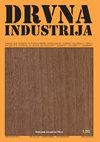枯草芽孢杆菌和毛孢菌对火炬松心材的生物降解及微尺度处理模式
IF 0.8
4区 农林科学
Q4 MATERIALS SCIENCE, PAPER & WOOD
引用次数: 2
摘要
提高耐火木材可加工性的一种策略是生物切割,其效率取决于微生物如何改变木材的多孔结构。因此,在微观尺度上评价生物切割木材的可加工性有助于更好地了解可加工性增强机制。采用白腐菌玻璃体物理菌(Physisporinus vitreus, Pers)对火炬松(Pinus taeda L.)心材进行了生物降解和微尺度处理。:(Fr.) P. Karsten分离物136和枯草芽孢杆菌UTB22。将尺寸为50 mm × 25 mm × 15 mm (L × T × R)的干燥标本与微生物在(23±2)℃和(65±5)%的相对湿度下培养6周。将对照木块和暴露木块用含1%荧光染料(荧光素)的水加压处理,在荧光显微镜下观察其可处理性。在孵育期结束时,还测定了试件的纵向和切向透气性以及平行于颗粒的抗压强度。扫描电镜(SEM)研究表明,枯草芽孢杆菌UTB22的降解仅限于胞穴膜,玻璃体芽孢杆菌对细胞壁也有一定程度的降解。与细菌相比,真菌造成的质量损失更大,而细菌的渗透性增强能力更明显。荧光染料示踪也显示枯草芽孢杆菌UTB22具有较高的处理能力和较强的均匀性。这两种微生物处理能力的提高主要是由于对早木管胞的降解。本文章由计算机程序翻译,如有差异,请以英文原文为准。
Biodegradation and Micro- Scale Treatability Pattern of Loblolly Pine Heartwood Bioincised by Bacillus Subtilis and Physisporinus Vitreus
One strategy for improving the treatability of refractory wood species is biological incising, and
its efficiency depends on how the microorganisms modify the porous structure of the wood. Evaluation of the bioincised wood treatability on a micro-scale can thus help to better understand the treatability enhancing mechanisms. In the present study, the biodegradation pattern and micro-scale treatability of Loblolly pine (Pinus taeda L.) heartwood were determined after bioincising with the white-rot fungus Physisporinus vitreus (Pers.: Fr.) P. Karsten isolate 136 and bacterium Bacillus subtilis UTB22. Oven-dried specimens with dimensions of 50 mm × 25 mm × 15 mm (L × T × R) were incubated with the microorganisms at (23±2) °C and (65±5) % relative humidity for six weeks. The control and exposed wood blocks were then pressure treated by 1 % fluorescent dye (fluorescein)-containing water to study the treatability pattern under a fluorescence microscope. The longitudinal and tangential air permeability and compression strength parallel to the grain of the specimens were also determined at the end of the incubation period. Scanning electron microscopic (SEM) studies showed that degradation by B. subtilis UTB22 was limited to the pit membranes, but the cell walls were also degraded to some extent by P. vitreus. The fungus caused a higher mass loss compared to the bacterium, whereas the permeability enhancing ability of the bacterium was more pronounced. The fluorescent dye tracer also showed that higher treatability with more uniformity was obtained by B. subtilis UTB22. The improvement in treatability by both microorganisms was mainly due to the degradation of the earlywood tracheids.
求助全文
通过发布文献求助,成功后即可免费获取论文全文。
去求助
来源期刊

Drvna Industrija
MATERIALS SCIENCE, PAPER & WOOD-
CiteScore
1.80
自引率
9.10%
发文量
32
审稿时长
>12 weeks
期刊介绍:
"Drvna industrija" ("Wood Industry") journal publishes original scientific and review papers, short notes, professional papers, conference papers, reports, professional information, bibliographical and survey articles and general notes relating to the forestry exploitation, biology, chemistry, physics and technology of wood, pulp and paper and wood components, including production, management and marketing aspects in the woodworking industry.
 求助内容:
求助内容: 应助结果提醒方式:
应助结果提醒方式:


